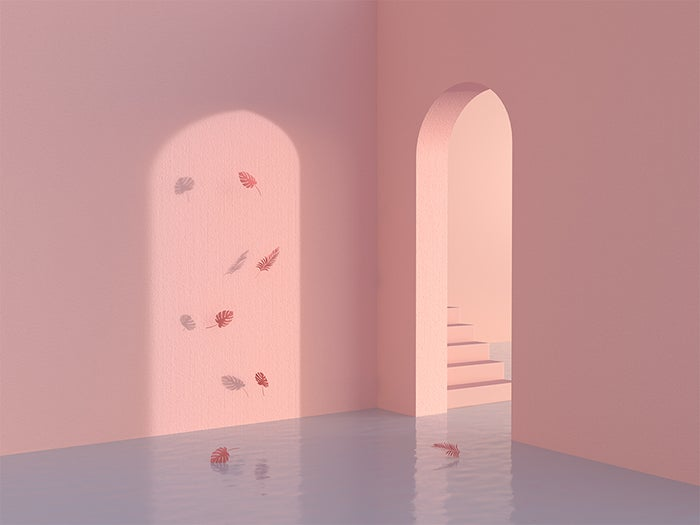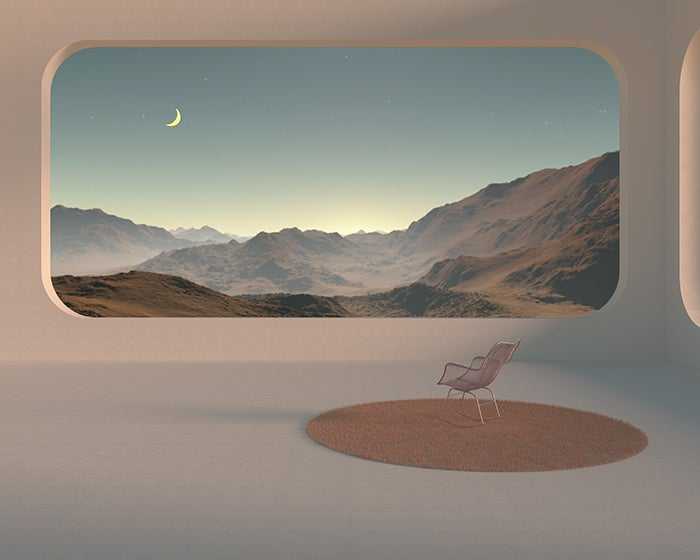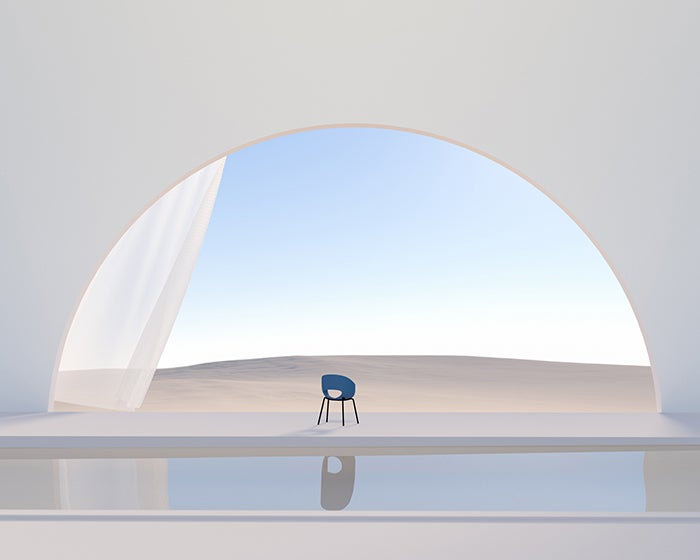Mue Studio: Their history, inspiration, and art

Blue Room, made in Dimension by Mue Studio.
Last month, we had the opportunity to collaborate on a stunning tutorial with Minjin Kang and Mijoo Kim, the visual art team behind Mue Studio. Using this collection of 27 free 3D assets from Adobe Stock and Dimension, Mijoo and Minjin took us through the steps to create this breathtaking Leaves on Water Scene, inspired by the 2020 Design Trend, Semi-Surreal.

Leaves on Water by Mue Studio.
As part of this collaboration, we wanted to give the creative community the opportunity to learn more about Minjin and Mijoo’s background, inspiration, and artistic vision. Their works – soft, open, dream-like compositions – have a distinctive visual aesthetic, and are particularly insightful and conceptually relevant during these tumultuous times. Learn more about these two amazing artists and what continues to drive their art forward.
Tell us about your individual backgrounds? What led you down your respective creative paths and inspired you to express yourself with visual art?
Mijoo: I originally studied computer science and statistics in college. During my junior year, I became fascinated by photography as an art form and eventually transferred programs to pursue the goal of becoming a documentary photographer. I was inspired by artists like Henri Cartier-Bresson and Josef Koudelka, pioneers of street photography, who captured unique portraits and city scenes. I was fascinated by the way in which they documented what have been called “decisive moments” and emphasized not only what is seen, but also the way in which it’s seen.
I believe that photography should say something, have meaning, and be socially enlightening. I began focusing my photographic work on immigrant laborers and female divers in Korea (called haenyo). I was particularly interested in understanding and representing this group and the way in which their lives were portrayed within our society. Through the series of Haenyo, The Mother of the Sea, I wanted to share not only the female divers’ beauty, but also their courage and tenacity when facing difficulties in their own lives.
Minjin: My grandfather and I were always very close. When I was about to lose him to lung cancer, I was unable to imagine life without him. I needed to have something to remember him by when he was gone. I tried taking photos to document his struggles with cancer, but that was too torturous and difficult for us both. I then had an idea of a different way I could approach this life-changing moment. My grandfather had a lot of friends. I realized that, if I could capture portraits of his friends, I could have a way to remember him and who he was as a person.
As I began to photograph these people, I began to learn more about my grandfather’s life and who he was. My first photo series, Grandfather, represented him through these portraits and allowed me to remember him as a happy, healthy person. This was the moment that I realized the power of creativity.
When and how did you meet? What led you to become a visual art team under the name Mue Studio?
Minjin & Mijoo: We were introduced to each other when we both transferred to the School of Art Institute of Chicago in 2006, and became friends while working in the same darkroom together. Throughout art school, we provided feedback on each other’s work and started to provide assistance and support when needed. In 2015, we both moved to New York City and decided to start collaborating together more closely. Our first project was the series Coney Island: Paradise at the End of New York, and we began to travel to other cities, working together as a creative duo.

Astro Tower and Thunderbolt from Coney Island: Paradise at the End of New York by Mue Studio.
How does the artistic development process work for you as a visual art team?
Minjin & Mijoo: We have weekly discussions around inspiration and what creative steps interest us (individually and as collaborators). These conversations fuel our artistic process and can include sketches, draft concepts, and post-processing work that help to add context to our meetings. We believe that what moves our collaboration forward are the ongoing conversations that we have together and the sharing of each other’s inspiration and vision.
What led you from photography to 3D?
Minjin & Mijoo: We both have a background in photography, but had been thinking a lot about our artistic futures. We were inspired by the idea that photography could soon go beyond its traditional 2D boundaries. During this time, we had a chance to attend Adobe MAX (both 2016 and 2017) and were introduced to Adobe Dimension (formerly called Project Felix). We realized that this design tool could be a powerful way to push our creative boundaries from 2D into 3D.

Young Moon from Somewhere in the World by Mue Studio.
Are there connections for you between 2D and 3D? What are some of the unique attributes of both mediums?
Minjin & Mijoo: There are some commonalities as well as differences between photography and 3D. An important difference is that, with 3D, you start your work from an empty canvas with no visual foundation point. Documentary photography works from the other end of the spectrum. You start with a pre-existing visual space, often limited by location, time, and weather, and then use photographic techniques to reframe or reconfigure the scene.
Regardless of these differences, the end goal with both mediums – as with any artistic process – is to capture that final work as you envisioned it, even if the road you took there was different each time.

The Modern Paradise, Calpe, Spain (photo) and Pink Cloud over the Ocean from Somewhere in the World (3D render) by Mue Studio.
Your work utilizes a uniform color palette, leveraging soft tones of blue and pink. What does color contribute to your work?
Minjin & Mijoo: Color is one of the most significant aspects of our work and choosing the colors are an integral part of the artistic process. The final color palette enables us to convey a specific mood or feeling. These types of soft colors bring to each scene a sense of peace, clarity, and even protection. We believe that color is one of the strongest ways to describe and convey subtle emotions.
Your design style is minimalistic in nature with a strong use of open spaces and soft, directional light. There is an otherworldly, dream-like quality. What attracts you to these visual elements?
Minjin & Mijoo: Minimalism and a clean, open design style has continued to be the best way to represent our vision. Our approach originates in a ‘less is more’ sensibility, which can be the most effective way to convey a comfortable moment to others. It can be difficult for people to find comfort with a work or a scene when the composition is too cluttered.
Combined with this, the soft light and directionally lit compositions are intended to imply early dawn or dusk, those moments of sunrise and sunset when people are most open to the world. Using a morning or evening sky opens up a full spectrum of colors, and in the larger context of psychology, represents the cycle of nature, including that of the human race and other living beings. We use sunrise and sunset to provoke feelings through colors, tones, and composition. These are the visual cues that help to communicate subtle emotions like melancholy and peacefulness to others.

Staycation from Somewhere in the World by Mue Studio.
Where do you find inspiration? What are the things that you see or experience that contribute to your creative vision?
Minjin: I find inspiration in everything that I experience on a daily basis. One of these is New York City, which is the perfect place for someone like me, who likes to walk and explore. Everything that I see, hear, and feel on these streets inspires me creatively. Because I live in a constantly crowded state of mind, both physically and emotionally, I tend to present the opposite sense of being in my visual work.
Mijoo: As a long-time photographer, I have always been interested in other mediums and engaging with artists who work in a variety of artistic disciplines. These artists who have inspired me are from every walk of life; from painters to sculptors to the musicians. Like for Minjin, this inspiration is combined with the architecture and culture that I see daily when walking down the street. I am keenly interested in human beings and the environments in which they live.
There are so many things happening in the world today. Your work projects a sense of calm and peace. What do you hope others take away from these scenes at this time?
Minjin: Maintaining a sense of peace and calm can sometimes be a difficult task. With my visual work, I want people to believe that these images truly exist somewhere in the world. I want to convey a sense of peace, calm, and comfort. My message remains the same: In a world where people are connected through digital means, packed with visual content, the goal is to create a mental rest stop – a place for others to escape into and to have hope.
Mijoo: My role as an artist is to create work that gives people comfort and inspires us all to dream of a better world. I want everyone to feel better about the current state of things, to feel better about a society that can sometimes be harsh and abrasive. Minjin and I always appreciate when we hear comments like, “these images are calm,” or “this is like visual ASMR.” This feedback fuels me as an artist. I appreciate when people share their thoughts, memories, and stories that are inspired by one of our works.

Breeze from Somewhere in the World by Mue Studio.
If you could use three words to describe your own work, what would these words be and why?
Minjin & Mijoo: We would use meditative, illusional, and surreal. We are interested in blurring and exploring the boundaries that exist between fantasy and reality. We invite people to enter into a dreamlike space, to step inside our series, Somewhere in the World. It is a place which might not exist, but one that you can believe in. There is a chance it is somewhere out there.
How do you see your work tying into the larger social and cultural discourse semi-surrealism?
Minjin & Mijoo: We are living in a world that is connected more than ever, especially through digital communication and social media. Yet we, as a society, sometimes feel that our emotional and social connections are actually fading away. The pandemic has further separated society by adding an physical divide. While the advantages of technology should be there to connect us and foster a stronger sense of community, the opposite seems to be happening. We seem to feel more isolated and disengaged. At times, people have the desire to run away from the ugliness and loneliness that may be out there in the world. In many ways, semi-surrealism offers everyone the opportunity to escape from these struggles, and through our work, we hope, to find a safe harbor in the storm.
To learn more about these two amazing artists and their work, visit the website of Minjin Kang and Mijoo Kim of Mue Studio.